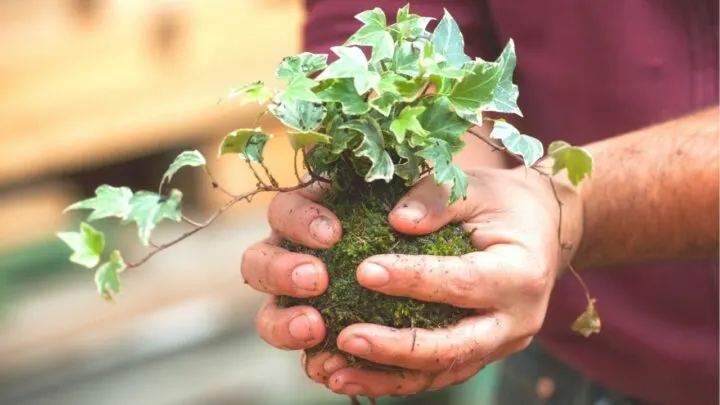Kokedama is a Japanese technique for growing plants inside hanging moss balls. The idea is for the plants to be exhibited without a pot for an extremely unique aesthetic. Usually, they are displayed by hanging from strings.
Originating from the Bonsai tradition where growers wanted to exhibit the roots, kokedama is an art form that requires special care.
If you think about it though, growing houseplants in small moss balls makes it difficult for you to provide the most ideal conditions.
Make the best of your kokedama growing experience by choosing plants that are well suited for this technique.
Hardy houseplants that stay small, grow slowly and are tolerant to less than ideal conditions are the best houseplants for Kokedama.
Avoid plants that grow too large or too quickly like monstera and wait until you’re more experienced to try kokedama with finicky plants. With practice, you can work your way to taking care of more sensitive plants.
Your key to success will be choosing the right plant for kokedama. Before you begin, please consider where you’ll want to hang the kokedama and base the plant you select on the light and humidity conditions in that location.
Table of Contents
What are the best plants for Kokedama?
- Cebu Blue Pothos (Epipremnum pinnatum)
- Tiger Cub Bromeliad (Noeregelia ampullacea)
- Chinese Money Plant (Pilea polybotrya)
- Dwarf ZZ Plant (Zamioculcas Zamiifolia)
- Ivy Peperomia (Peperomia griseoargentea)
- Croton (Codiaeum variegatum)
- Peace Lily (Spathiphyllum wallisii)
- Nerve Plant (Fittonia albivenis)
- Rabbit Foot Fern (Davallia fejeensis)
- Super Dwarf Red Vine (Philodendron)
- Spider Plant (Chlorophytum comosum)
- Pineapple Mint (Mentha suaveolens)
- Ficus Tree Bonsai (Ficus retusa bonsai)
1. Epipremnum Pinnatum (Cebu Blue Pothos)
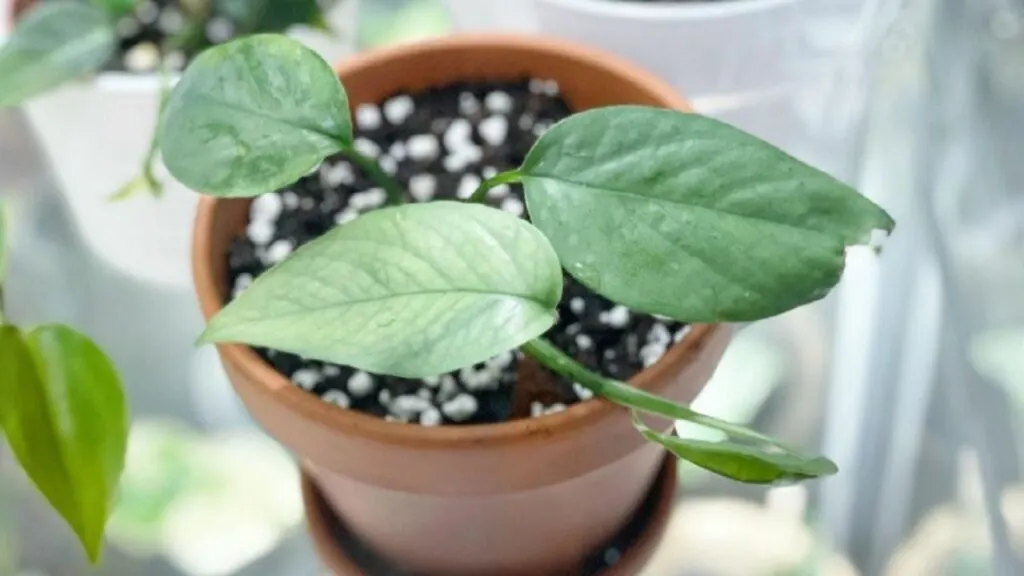
Photo Credit: @smallplanty on Instagram!
When I first started getting into houseplants one of the first in my collection was a pothos. The whole family of pothos plants is easy to take care of and feature really stunning foliage.
The plants are easily pruned and propagated and can be grown vertically as they cling to a central pole or you can let the vines hang.
For kokedama, pothos’ trailing foliage creates a beautiful effect as it cascades from the central moss ball.
Another benefit of pothos if you can easily keep them small by trimming the ends. Easily propagate the pothos vines through cuttings to create a bunch of kokedama for you and to give away.
Of all the pothos, I recommend looking for the Cebu Blue variety for your kokedama. The dark green foliage is stunningly beautiful and pairs well with the mossy green base.
In its natural habitat, Cebu Blue pothos grows as an epiphytic plant. Epiphytic plants are particularly well suited for kokedama since they are used to growing off of other living organisms.
Another great aspect of the Cebu Blue pothos is that the foliage resembles the beloved monstera plant.
Monsteras are too large and fast-growing for kokedama but you can achieve the same look and feel with Epipremnum pinnatum.
2. Neoregelia ampullacea (Tiger Cub Bromeliad)
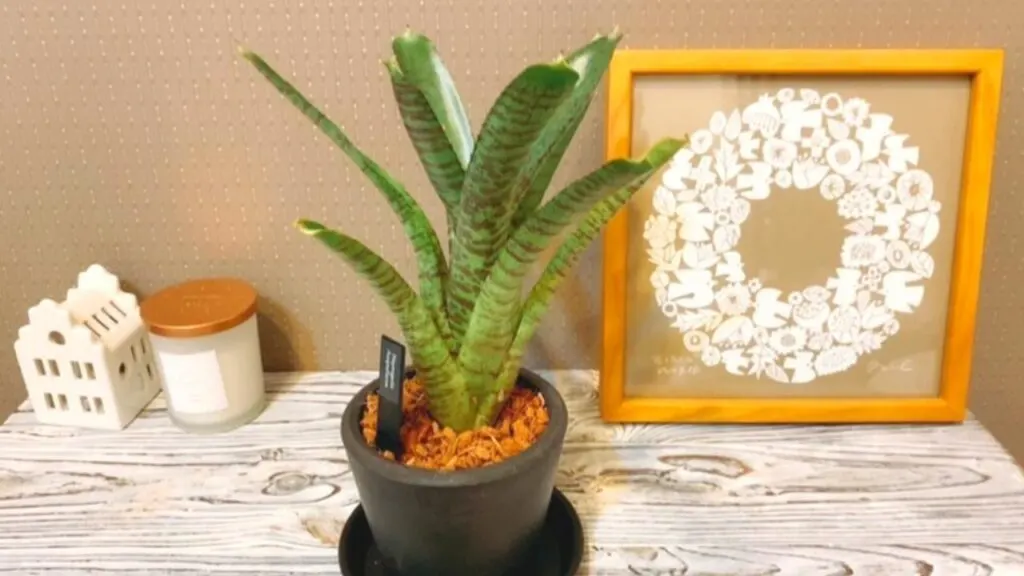
Photo Credit: @miica.mm on Instagram!
Bromeliads are probably the best-adapted plants for growing in kokedama because their natural habitats are quite similar.
In the wild, bromeliads are often found growing on the trunks of trees amongst bunches of accumulated moss and fallen leaves. The plants survive by collecting rainwater in the crevices and enjoying the nutrients from decomposing organic matter.
In kokedama, you’ll be providing the water and nutrients, but the result will be largely the same. When choosing what bromeliad to plant in your kokedama, you’ll want to think about the size of the plant upon maturity and choose a miniature variety.
One of my favorite tiny bromeliads is the Tiger Cub variety which maintains a size of about 6 by 5 inches and features crazy-looking red stripes across the leaves.
Provided proper care, you’ll have an easy time maintaining this bromeliad in a kokedama. The small size will let you enjoy it since it won’t outgrow its moss ball so quickly and the beautiful coloring will make it stand out.
3. Pilea Polybotrya (Chinese Money plant)
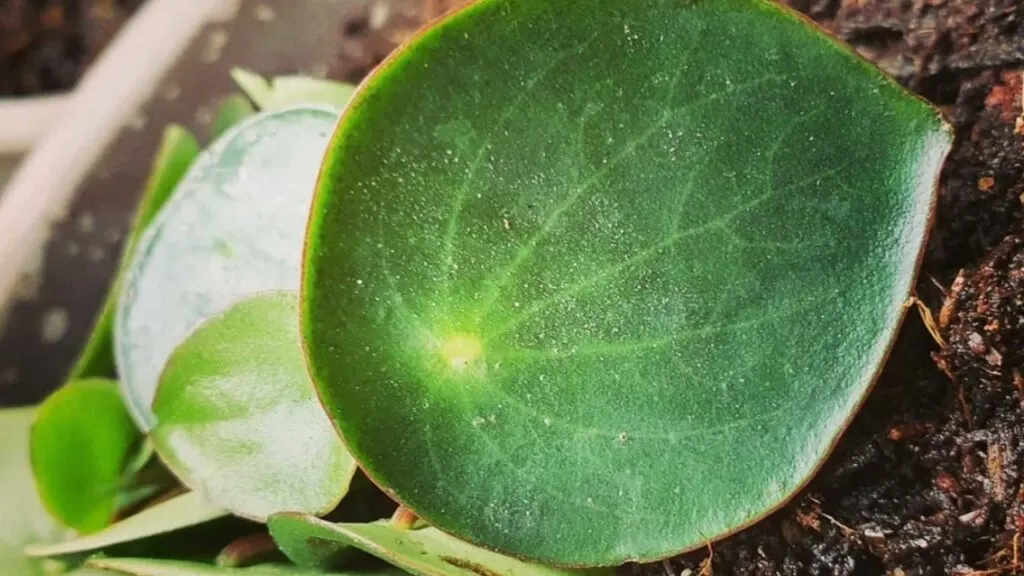
Photo Credit: @everythinggrowz on Instagram!
If you live in a small, urban area and already have some houseplants, you’ve probably already got a pilea in your collection.
The same characteristics that make this plant a great choice for newbie plant parents in urban settings also make it a great choice for kokedama.
Chinese Money plants are compact little houseplants that are easy to care for. Their leaves resemble alien saucers flying out, which gives them an out-of-this-world aesthetic.
When planted in a kokedama moss ball, the plant has an even more peculiar if not comedic look.
The common variety of Pilea is called Pilea peperomioides but a more compact variety that is even better suited for kokedama is Pilea polybotrya. If you can’t find a polybotrya variety, don’t stress. All Pileas are quite compact and forgiving of their care.
4. Zamioculcas Zamiifolia ‘Zenzi’ (Dwarf ZZ Plant)
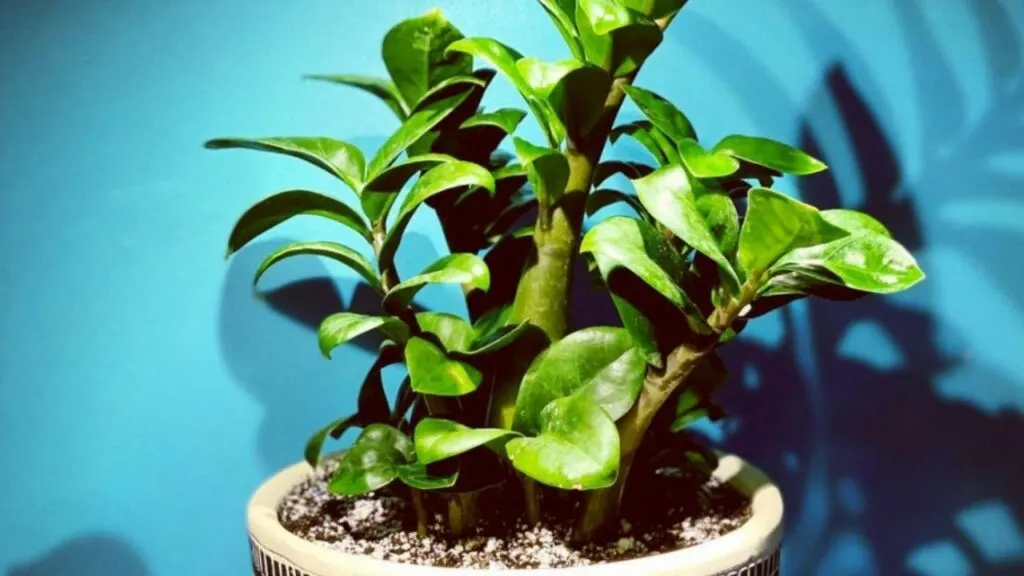
Photo Credit: @oliversjungle on Instagram!
I love ZZ plants and they are the houseplant I recommend to anyone who declares themselves a brown thumb. They are often referred to as the ‘unkillable’ plant because they are truly resistant to both severe neglect and over-parenting.
These resilient qualities make ZZ plants one of the best for someone wanting to try kokedama for the first time.
It is difficult to keep plants thriving in kokedama because it’s challenging for the gardener to control the conditions.
When first dunked in water the moss ball will retain a lot of humidity but with time will dry out. So you need to find plants that can withstand periods of high moisture with periods of drought.
ZZ plants normally get quite large, which is why they are often excluded from the list of plants for kokedama.
I would challenge this however and encourage you to find a dwarf variety where you can take advantage of the ZZ plant’s low maintenance while still enjoying it for a long time.
The Zenzi variety is an adorable option that you might even want to consider growing in pots as well. If you purchase a Zenzi ZZ plant try separating out an individual stem when you go to pot it up.
Use the individual stem for kokedama (so it has space to put out new growth) and plant the rest of the clump in a pot. This way you’ll be able to make a new dwarf ZZ plant kokedama whenever you repot or propagate the mother Zenzi plant.
5. Peperomia Griseoargentea (Ivy Peperomia)
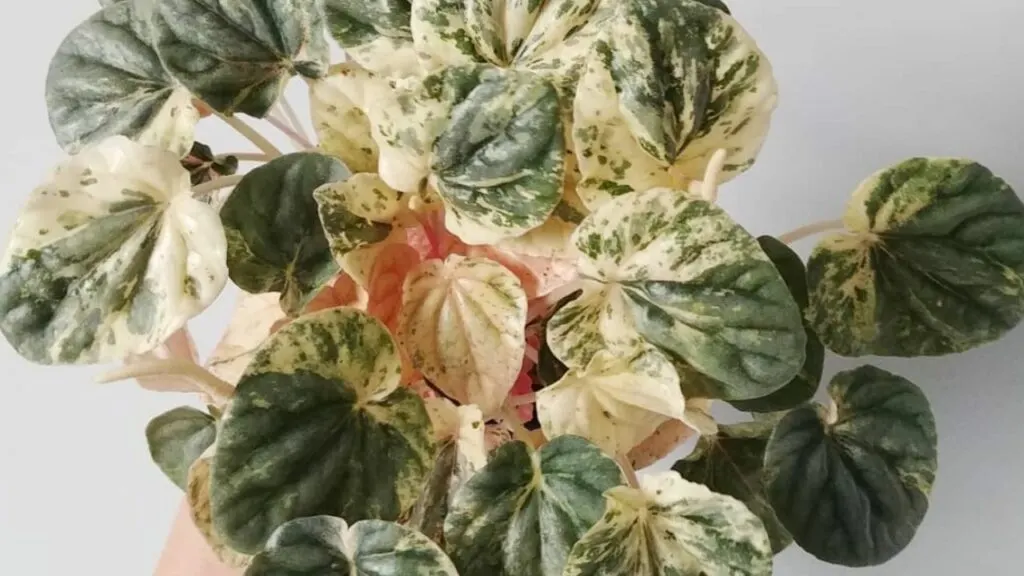
Photo Credit: @pforplant on Instagram!
Ivy peperomia is an ivy-like succulent that features shimmery, trailing stems. It’s a beautiful compact plant that usually graces desks and narrow shelves due to its small size.
For kokedama, it’s a perfect plant because it only needs moderate watering and it has a shallow root system. Resistance to periods of drought makes it particularly well suited to withstand the periods between waterings that are normal for kokedama.
The shallow root system and preference for small pots means that it will also take well to the small moss ball. Ivy peperomia likes to have a small area for its roots and doesn’t need frequent transplanting. These features make it a great plant for kokedama.
Other small succulents such as a Zebra cactus also make great options for kokedama. Succulents are particularly amazing for these growing conditions because they can tolerate drought and don’t normally grow very quickly.
Additionally, it can be quite a stunning visual to see these drought-tolerant plants that are normally found in rock and desert gardens be featured in lush, suspended moss balls.
6. Codiaeum Variegatum (Croton)
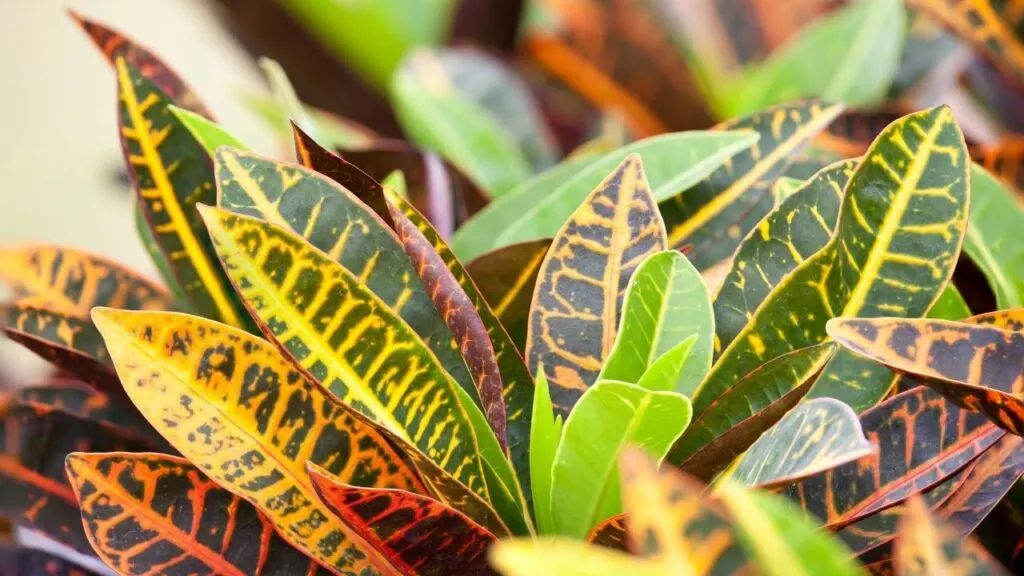
One of the first houseplants I ever got was a beautiful croton with the most colorful leaves. I remember being completely amazed as the plant put out new dark green growth, which then became a colorful rainbow with exposure to the sun.
Crotons are some of the houseplants that do well in full sun. If you’re looking to hang your kokedama in front of a window or someplace that gets direct light, crotons are your best bet.
Although crotons can get quite large, they don’t grow so quickly especially if you keep them in small containers, don’t fertilize them, and practice pinching off new growth.
Also, start out with a small plant or miniature variety that will help you enjoy your croton kokedama for the longest amount of time possible.
Mammy crotons are one of the smaller varieties and you can sometimes even find a Mammy dwarf corkscrew croton that will stay miniature.
If you’re not too concerned with having multi-colored foliage Banana crotons are another smaller variety that will do well in kokedama.
7. Spathiphyllum wallisii (Peace Lily)
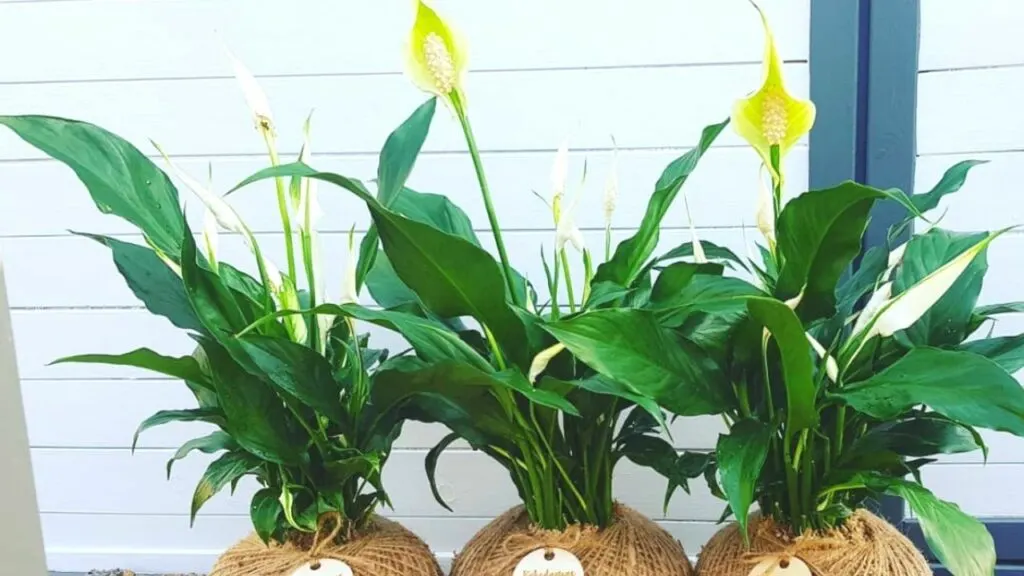
Photo Credit: @kokedamasbytrace on Instagram!
If you’re looking for a flowering plant to display in your kokedama, Peace Lilies are an amazing choice.
Spathiphyllum wallisii is an aeroid, which means that waxy leaves protect it from both under and over-watering. This resilience makes it tolerate the unique conditions of kokedama.
Although Peace Lilies can droop over quite dramatically when they are under-watered, dunking the moss ball in water for a few minutes will hydrate and perk them right up.
If you have a Peace Lilly growing in your kokedama, just make sure to use filtered water when you give it a dunk. These plants can be sensitive to harsh components in the water and the leaves will turn brown.
Another thing to note is that Peace Lilies are a fast-growing plant. So although you’ll enjoy the beautiful blooms, they won’t last more than a few seasons. Prolong the amount of time your Peace Lilly will be happy in its moss ball by seeking out a dwarf variety.
8. Fittonia Albivenis (Nerve Plant)
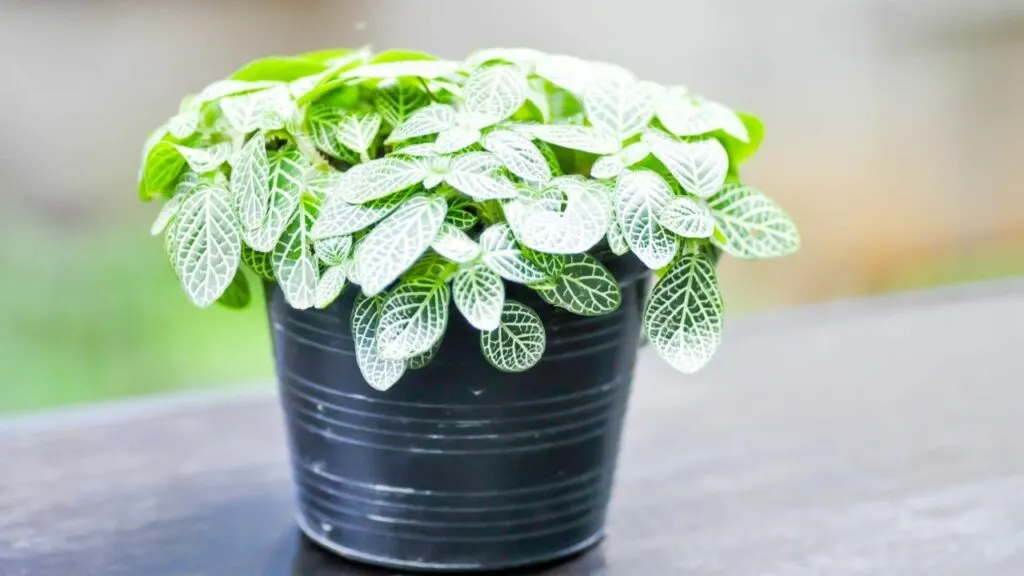
Nerve plants are another flowering plant you can try growing for kokedama. Their small size and colorful leaves make them one of the most colorful plant families that are also well suited for kokedama.
The dark green leaves with yellow, red, or white veins stand out against the dark green or brown kokedama moss ball. As long as you provide them with plenty of humidity you’ll be able to keep your nerve plant kokedama in good condition for many years.
Nerve plants will do best if hung in a low-light area with lots of humidity. They don’t need much light, so if you want to hang your kokedama in a place without a lot of sunlight then nerve plants are a great choice.
The biggest drawback to nerve plants is that they require high humidity. You can anticipate their needs by placing them in a bathroom, spraying them with water every day, or by hanging them above your houseplant collection.
These humid microclimates around your house will give them the conditions they need.
9. Davallia Fejeensis (Rabbit foot Fern)
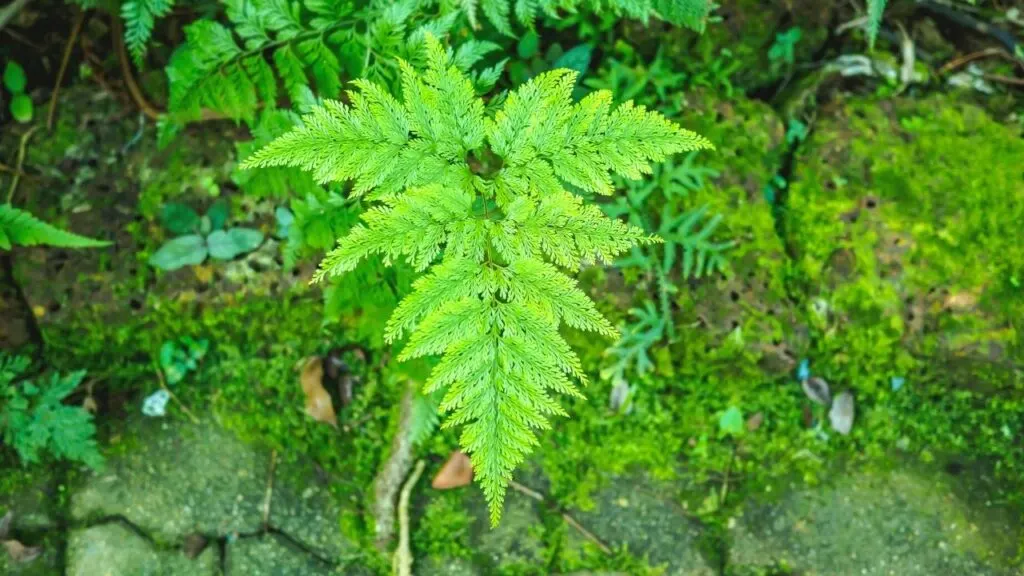
Ferns can be a great plant for your kokedama, but it’s important to choose the right variety. Keep in mind that each fern variety will have different preferences and varying levels of tolerance for less than ideal conditions.
Maidenhair ferns, for example, are extremely sensitive to light and humidity conditions won’t adapt well to a kokedama environment. Instead, choose a hardier variety of ferns such as a rabbit’s foot fern or a blue star fern that won’t be so sensitive to low humidity.
Other ferns such as asparagus ferns adapt well to kokedama and look stunning when they’re young. Unfortunately, their fast-growing patterns make it difficult to maintain and the plant will quickly outgrow the host.
You can help to keep your plants small by starting off with a small cutting, for example, and pruning them often.
10. Philodendron (Super dwarf red vine)
Like pothos plants, philodendrons are well suited for kokedama because they are quite resilient to dry conditions and low light.
These plants are easy to keep alive and will therefore make your life that much easier when growing these plants for kokedama.
The downside to growing philodendrons (and pothos) in a kokedama is that they are really fast-growing plants that need frequent repotting to prevent them from becoming root-bound.
To avoid your plant outgrowing the moss ball before you’ve had time to enjoy it, make sure to select a miniature or dwarf variety of philodendron. These can be harder to find but will be much more suited for kokedama.
One of my favorite small varieties of philodendrons is the super dwarf red vine. It is normally used for terrariums because it only reaches 5 inches when fully mature.
This small size will let you keep it in as a kokedama plant for its entire lifecycle. Aesthetically, the bright red stems will look incredible coming out of the kokedama moss ball.
If you can’t get your hands on a dwarf variety, no stress. You can take clippings from whatever philodendron you have at home and plant a single cutting in the kokedama. Just be aware that it will eventually outgrow this medium and you’ll have to adjust accordingly.
11. Chlorophytum Comosum (Spider Plant)
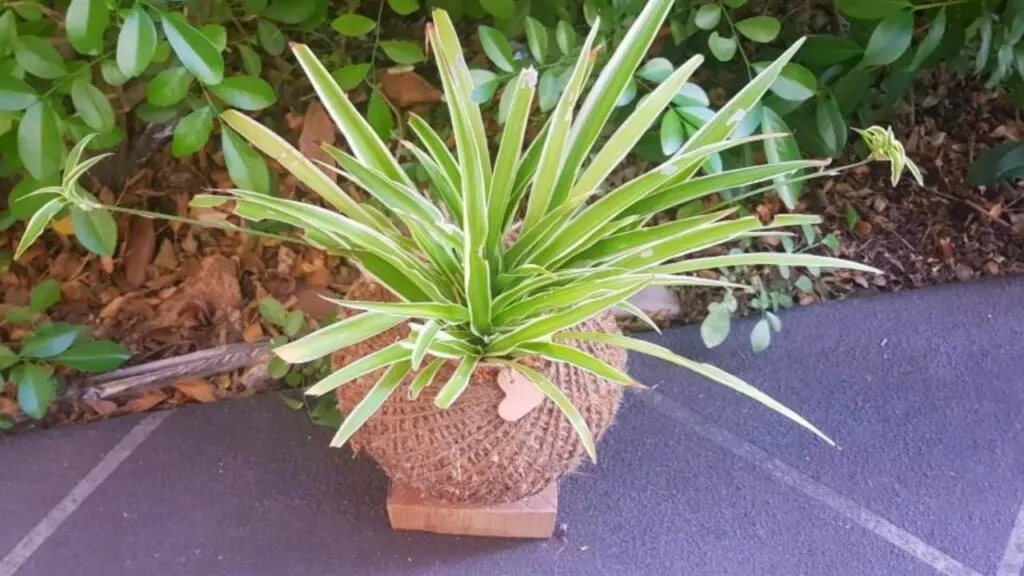
Photo Credit: @kokedamasbytrace on Instagram!
Spider plants are another easy-to-care-for houseplant that will adapt well to kokedama. These low-maintenance plants are a staple in houseplant collections.
Spider plants will tolerate low light conditions. So if you’re looking to hang your kokedama away from bright light, your choice in plants becomes a lot smaller. Spider plants are one of a few houseplants that will do ok in low-light conditions.
Another reason why spider plants are particularly well suited for kokedama is that they actually like small growing spaces and enjoy becoming root-bound.
When planting in pots, this means you’ll want to stick to small pots and wait until the roots start poking out from the top of the soil.
For kokedama, this means that you’ll be able to enjoy the display for that much longer. Since spider plants are fast-growing plants, it would be extremely hard to keep up with their growth if they didn’t enjoy being root-bound.
If you already have a spider plant at home, you don’t need to look any further to plant your kokedama. When your ‘mother’ plant puts out a side shoot with its individual rosette, you can put this off from the main plant and use it for your kokedama.
The small size of the rosette and the developing root system will give you plenty of time to enjoy the kokedama while the plant matures and fills out the moss ball.
12. Mentha suaveolens (Pineapple Mint)
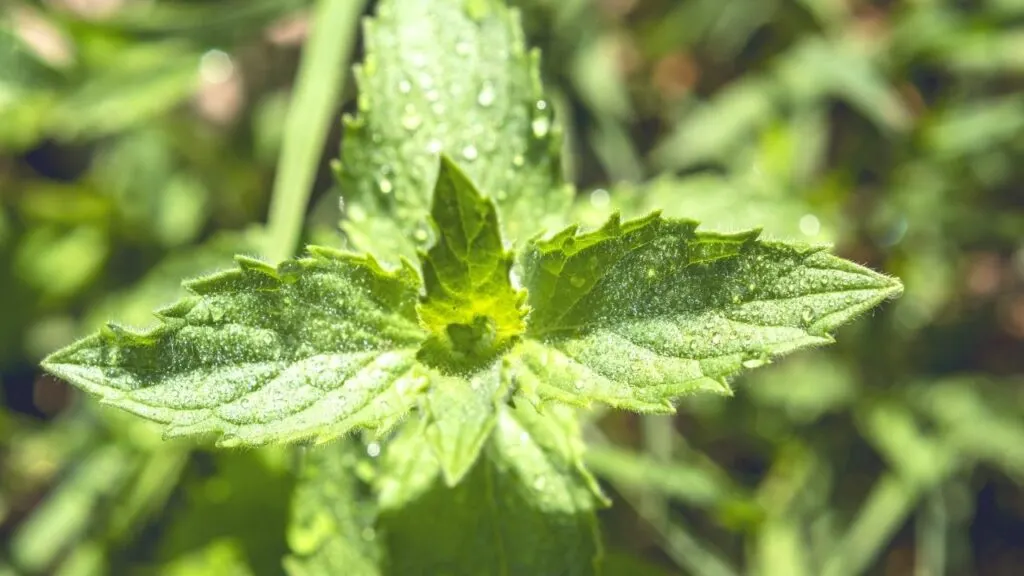
Try making an edible kokedama by planting mint in the moss ball. If you’ve ever tried growing mint, you might know that it’s extremely difficult to kill and usually ends up taking over garden pots and raised beds. This resilient quality makes it particularly well suited for kokedama.
I personally love unusual varieties of mint that you can’t find at the grocery store. Keep an eye out for pineapple mint, which will have a sweeter and tropical taste. You can find stunning varieties of variegated mint that will stand out against the dark moss and coconut coir.
Not only will your mint kokedama be an exciting way to display this edible herb, but it will also release the most delightful scent throughout the day. Depending on the specific variety it will either trail down the kokedama or root itself around the moss ball.
Keep your edible mint kokedama in a bright spot in your kitchen where you can water it frequently and it will be accessible for a quick tea or a bit of flavor.
13. Ficus Retusa Bonsai (Ficus Tree Bonsai)

Kokedama stems from the bonsai tradition where bonsai trees were grown in a suspended medium to show off the root system.
With time, the roots would completely cover the medium and moss would begin growing on the outside. This artful tradition evolved to become the moss ball kokedama that has become a stylish houseplant trend.
Although keeping a bonsai in kokedama is not for beginners, it’s something you can work up to with practice. If you already have some experience with growing plants for kokedama and want an extra challenge, level up with bonsai trees.
Bonsais are any tree that has been strategically pruned to keep it small. Technically, any tree can be a bonsai but when growing for kokedama I would recommend trying with a ficus. Ficus trees are quite resistant to low humidity and will tolerate occasional periods of drought.
The resilience of ficus trees makes them great houseplants since they acclimate to indoor conditions. These forgiving traits also make it the best tree to bonsai for kokedama.
Conclusion
Are you an experienced gardener looking to try something new? Or are you just fascinated by the idea of growing plants in a suspended moss ball?
Whatever the reason, kokedama is a fascinating technique for growing plants that can be adapted for indoor houseplant conditions.
When starting on your kokedama journey, do your research on how to create the moss ball but focus most of your energy on selecting the right plant. Choosing the best plant for kokedama will depend entirely on your specific conditions.
The best plant for my sunny kitchen will not be the same as the best plant for your dark and humid bathroom. However, some general guidelines will make your kokedama experience that much more enjoyable.
First, choose a plant that is easy to care for. There’s a learning curve when it comes to kokedama so don’t make it more difficult by choosing a fussy plant. Easy to care for plants like ZZs and succulents will be forgiving of any mistakes you might make.
Second, choose a small variety. You can’t just repot kokedama plants like you would if they were potted in standard containers. This means that scaling up the size to accommodate new growth is out of the question.
Control for this by choosing a dwarf variety that will stay small through maturity. Or choose a slow-growing plant that doesn’t need to be repotted often.
Lastly, consider the light and temperature conditions of where you’ll hang the kokedama before choosing the plant variety. Because they’re suspended, kokedamas aren’t easily moved and are particularly sensitive to drafts.
Maintaining a kokedama plant takes practice and can be very different from caring for potted houseplants. Don’t discourage yourself by getting too complicated and start with the easiest plant to care for.
Small succulents, beginner houseplants, and plants with similar growing conditions in the wild (like bromeliads) will make the best plants for kokedama.

Daniel has been a plant enthusiast for over 20 years. He owns hundreds of houseplants and prepares for the chili growing seasons yearly with great anticipation. His favorite plants are plant species in the Araceae family, such as Monstera, Philodendron, and Anthurium. He also loves gardening and is growing hot peppers, tomatoes, and many more vegetables.

